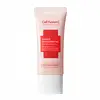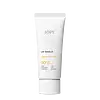What's inside
What's inside
 Key Ingredients
Key Ingredients

 Benefits
Benefits

 Concerns
Concerns

 Ingredients Side-by-side
Ingredients Side-by-side

Water
Skin ConditioningCyclopentasiloxane
EmollientZinc Oxide
Cosmetic ColorantHomosalate
Skin ConditioningEthylhexyl Salicylate
UV AbsorberCoco-Caprylate/Caprate
EmollientDipropylene Glycol
HumectantCaprylyl Methicone
Skin ConditioningTitanium Dioxide
Cosmetic ColorantLauryl PEG-10 Tris(Trimethylsiloxy)Silylethyl Dimethicone
EmulsifyingGlycerin
HumectantNiacinamide
SmoothingPhenyl Trimethicone
Skin ConditioningCitrus Aurantium Dulcis Peel Oil
MaskingOlea Europaea Fruit Oil
MaskingLavandula Angustifolia Oil
MaskingLilium Speciosum Flower Oil
MaskingOrbignya Oleifera Seed Oil
EmollientTocopheryl Acetate
AntioxidantDisteardimonium Hectorite
StabilisingMagnesium Sulfate
Methyl Methacrylate Crosspolymer
Vinyl Dimethicone/Methicone Silsesquioxane Crosspolymer
Dimethicone
Emollient1,2-Hexanediol
Skin ConditioningTriethoxycaprylylsilane
Stearic Acid
CleansingAluminum Hydroxide
EmollientSorbitan Caprylate
EmulsifyingDicaprylyl Carbonate
EmollientDimethicone/PEG-10/15 Crosspolymer
Glyceryl Caprylate
EmollientDimethicone/Vinyl Dimethicone Crosspolymer
Skin ConditioningEthylhexylglycerin
Skin ConditioningAdenosine
Skin ConditioningSodium Hyaluronate
HumectantBisabolol
MaskingSodium Citrate
BufferingTocopherol
AntioxidantArbutin
AntioxidantHydrogenated Lecithin
EmulsifyingCeramide NP
Skin ConditioningSucrose Stearate
EmollientCholesterol
EmollientCholesteryl Macadamiate
EmollientPalmitic Acid
EmollientPolyglyceryl-10 Stearate
Skin ConditioningSodium Ascorbyl Phosphate
AntioxidantPanthenol
Skin ConditioningGlutathione
Glyceryl Linolenate
EmollientGlyceryl Arachidonate
EmollientRetinyl Palmitate
Skin ConditioningMenadione
MaskingBiotin
AntiseborrhoeicCyanocobalamin
Skin ConditioningSaccharide Isomerate
HumectantThiamine Hcl
MaskingPolyacrylic Acid
Emulsion StabilisingPyridoxine
Skin ConditioningHydrolyzed Lupine Protein
Skin ConditioningCI 77491
Cosmetic ColorantCI 77492
Cosmetic ColorantLimonene
PerfumingLinalool
PerfumingCitronellol
PerfumingWater, Cyclopentasiloxane, Zinc Oxide, Homosalate, Ethylhexyl Salicylate, Coco-Caprylate/Caprate, Dipropylene Glycol, Caprylyl Methicone, Titanium Dioxide, Lauryl PEG-10 Tris(Trimethylsiloxy)Silylethyl Dimethicone, Glycerin, Niacinamide, Phenyl Trimethicone, Citrus Aurantium Dulcis Peel Oil, Olea Europaea Fruit Oil, Lavandula Angustifolia Oil, Lilium Speciosum Flower Oil, Orbignya Oleifera Seed Oil, Tocopheryl Acetate, Disteardimonium Hectorite, Magnesium Sulfate, Methyl Methacrylate Crosspolymer, Vinyl Dimethicone/Methicone Silsesquioxane Crosspolymer, Dimethicone, 1,2-Hexanediol, Triethoxycaprylylsilane, Stearic Acid, Aluminum Hydroxide, Sorbitan Caprylate, Dicaprylyl Carbonate, Dimethicone/PEG-10/15 Crosspolymer, Glyceryl Caprylate, Dimethicone/Vinyl Dimethicone Crosspolymer, Ethylhexylglycerin, Adenosine, Sodium Hyaluronate, Bisabolol, Sodium Citrate, Tocopherol, Arbutin, Hydrogenated Lecithin, Ceramide NP, Sucrose Stearate, Cholesterol, Cholesteryl Macadamiate, Palmitic Acid, Polyglyceryl-10 Stearate, Sodium Ascorbyl Phosphate, Panthenol, Glutathione, Glyceryl Linolenate, Glyceryl Arachidonate, Retinyl Palmitate, Menadione, Biotin, Cyanocobalamin, Saccharide Isomerate, Thiamine Hcl, Polyacrylic Acid, Pyridoxine, Hydrolyzed Lupine Protein, CI 77491, CI 77492, Limonene, Linalool, Citronellol
Water
Skin ConditioningButylene Glycol
HumectantEthylhexyl Methoxycinnamate
UV AbsorberC12-15 Alkyl Benzoate
AntimicrobialBis-Ethylhexyloxyphenol Methoxyphenyl Triazine
Skin ConditioningDiethylamino Hydroxybenzoyl Hexyl Benzoate
UV FilterTitanium Dioxide
Cosmetic ColorantCyclopentasiloxane
EmollientNiacinamide
SmoothingDimethicone
EmollientSilica
AbrasiveCyclohexasiloxane
EmollientCetyl Alcohol
EmollientGlyceryl Stearate
EmollientPEG-100 Stearate
Trisiloxane
Skin ConditioningNylon-12
C14-22 Alcohols
Emulsion StabilisingPolyacrylate-13
Aluminum Stearate
Cosmetic ColorantParfum
MaskingPolyhydroxystearic Acid
EmulsifyingPolyisobutene
Alumina
AbrasiveStearic Acid
CleansingTocopheryl Acetate
AntioxidantC12-20 Alkyl Glucoside
EmulsifyingPolysilicone-11
C12-15 Alcohols
EmollientMethoxy PEG-114/Polyepsilon Caprolactone
BufferingGlyceryl Caprylate
EmollientBifida Ferment Lysate
Skin ConditioningCarbomer
Emulsion StabilisingCichorium Intybus Root Extract
MaskingEthylhexylglycerin
Skin ConditioningDisodium EDTA
Polysorbate 20
EmulsifyingAdenosine
Skin ConditioningSorbitan Isostearate
EmulsifyingPhenoxyethanol
PreservativeGossypium Herbaceum Extract
Skin ConditioningGlucose
HumectantSodium Benzoate
MaskingAcetic Acid
BufferingLactic Acid
BufferingTocopherol
AntioxidantWater, Butylene Glycol, Ethylhexyl Methoxycinnamate, C12-15 Alkyl Benzoate, Bis-Ethylhexyloxyphenol Methoxyphenyl Triazine, Diethylamino Hydroxybenzoyl Hexyl Benzoate, Titanium Dioxide, Cyclopentasiloxane, Niacinamide, Dimethicone, Silica, Cyclohexasiloxane, Cetyl Alcohol, Glyceryl Stearate, PEG-100 Stearate, Trisiloxane, Nylon-12, C14-22 Alcohols, Polyacrylate-13, Aluminum Stearate, Parfum, Polyhydroxystearic Acid, Polyisobutene, Alumina, Stearic Acid, Tocopheryl Acetate, C12-20 Alkyl Glucoside, Polysilicone-11, C12-15 Alcohols, Methoxy PEG-114/Polyepsilon Caprolactone, Glyceryl Caprylate, Bifida Ferment Lysate, Carbomer, Cichorium Intybus Root Extract, Ethylhexylglycerin, Disodium EDTA, Polysorbate 20, Adenosine, Sorbitan Isostearate, Phenoxyethanol, Gossypium Herbaceum Extract, Glucose, Sodium Benzoate, Acetic Acid, Lactic Acid, Tocopherol
 Reviews
Reviews

Ingredients Explained
These ingredients are found in both products.
Ingredients higher up in an ingredient list are typically present in a larger amount.
Adenosine is in every living organism. It is one of four components in nucleic acids that helps store our DNA.
Adenosine has many benefits when used. These benefits include hydrating the skin, smoothing skin, and reducing wrinkles. Once applied, adenosine increases collagen production. It also helps with improving firmness and tissue repair.
Studies have found adenosine may also help with wound healing.
In skincare products, Adenosine is usually derived from yeast.
Learn more about AdenosineCyclopentasiloxane, or D5, is a silicone used to improve texture of products and trap moisture.
D5 is considered lightweight and volatile. Volatile means it evaporates quickly after application. Once evaporated, D5 leaves a thin barrier that helps keep skin hydrated.
It is also an emollient. Emollients help soften the skin and prevent water loss. Silicones create a silky texture in products. D5 helps other ingredients become more spreadable.
Studies show D5 is safe to use in skincare products. We recommend speaking with a skincare professional if you have concerns.
Learn more about CyclopentasiloxaneDimethicone is a type of synthetic silicone created from natural materials such as quartz.
What it does:
Dimethicone comes in different viscosities:
Depending on the viscosity, dimethicone has different properties.
Ingredients lists don't always show which type is used, so we recommend reaching out to the brand if you have questions about the viscosity.
This ingredient is unlikely to cause irritation because it does not get absorbed into skin. However, people with silicone allergies should be careful about using this ingredient.
Note: Dimethicone may contribute to pilling. This is because it is not oil or water soluble, so pilling may occur when layered with products. When mixed with heavy oils in a formula, the outcome is also quite greasy.
Learn more about DimethiconeEthylhexylglycerin (we can't pronounce this either) is commonly used as a preservative and skin softener. It is derived from glyceryl.
You might see Ethylhexylglycerin often paired with other preservatives such as phenoxyethanol. Ethylhexylglycerin has been found to increase the effectiveness of these other preservatives.
Glyceryl Caprylate comes from glycerin and caprylic acid, a fatty acid from coconut. It has emollient and emulsifier properties.
As an emollient, it helps hydrate your skin. Emollients work by creating a barrier on your skin to trap moisture in, helping to keep your skin soft and smooth.
On the other hand, emulsifiers prevent ingredients (such as oil and water) from separating.
Learn more about Glyceryl CaprylateNiacinamide is a multitasking form of vitamin B3 that strengthens the skin barrier, reduces pores and dark spots, regulates oil, and improves signs of aging.
And the best part? It's gentle and well-tolerated by most skin types, including sensitive and reactive skin.
You might have heard of "niacin flush", or the reddening of skin that causes itchiness. Niacinamide has not been found to cause this.
In very rare cases, some individuals may not be able to tolerate niacinamide at all or experience an allergic reaction to it.
If you are experiencing flaking, irritation, and dryness with this ingredient, be sure to double check all your products as this ingredient can be found in all categories of skincare.
When incorporating niacinamide into your routine, look out for concentration amounts. Typically, 5% niacinamide provides benefits such as fading dark spots. However, if you have sensitive skin, it is better to begin with a smaller concentration.
When you apply niacinamide to your skin, your body converts it into nicotinamide adenine dinucleotide (NAD). NAD is an essential coenzyme that is already found in your cells as "fuel" and powers countless biological processes.
In your skin, NAD helps repair cell damage, produce new healthy cells, support collagen production, strengthen the skin barrier, and fight environmental stressors (like UV and pollution).
Our natural NAD levels start to decline with age, leading to slower skin repair, visible aging, and a weaker skin barrier. By providing your skin niacinamide, you're recharging your skin's NAD levels. This leads to stronger, healthier, and younger looking skin.
Another name for vitamin B3 is nicotinamide. This vitamin is water-soluble and our bodies don't store it. We obtain Vitamin B3 from either food or skincare. Meat, fish, wheat, yeast, and leafy greens contain vitamin B3.
The type of niacinamide used in skincare is synthetically created.
Learn more about NiacinamideStearic Acid is a fatty acid. It is an emollient, emulsifier, and texture enhancer.
As an emollient, stearic acid helps soften skin. It aids the skin's protective barrier by preventing water loss. It also provides a gentle cleansing effect without stripping away natural oils.
Stearic acid may also be used to enhance the texture of products. It can add volume and stabilize ingredients such as water and oil. This can help water and oil ingredients from separating.
Sources of stearic acid include animal or vegetable fats/oils such as coconut or shea. It can be naturally found in butter, cocoa butter, shea butter, vegetable fats, and animal tallow.
This ingredient may not be Malassezia folliculitis, or fungal-acne safe.
Learn more about Stearic AcidTitanium dioxide is a mineral UV filter widely used in sunscreens and cosmetics.
It is one of only two UV filters officially classified as “mineral” by regulatory agencies, the other being zinc oxide.
Titanium dioxide provides broad-spectrum protection mostly in the UVB and UVAII range, with some protection in the UVAI range.
While its UVA protection isn’t as strong as zinc oxide’s, the difference is minor.
A common myth is that mineral UV filters reflect UV light. However, modern research shows titanium dioxide absorbs UV radiation like chemical filters (~95% absorption & 5% reflection).
Thanks to its non-irritating nature, titanium dioxide is suitable for sensitive, acne-prone, or redness-prone skin. It is unlikely to cause "eye sting" like other sunscreen ingredients.
A major drawback of this ingredient is its white cast and thick texture. This is why mineral sunscreens often leave a white cast and are less cosmetically elegant than chemical/hybrid sunscreens.
To improve white cast and spreadability, micronized or nano-sized titanium dioxide is often used.
There are ongoing concerns surrounding nano-titanium oxide's impact on marine ecosystems.
There is no conclusive evidence that any form of titanium oxide (or any other sunscreen ingredients) will cause harm to marine ecosystems or coral reefs. The science is still developing but many consumers are keeping a close eye on this issue.
Please note, many destinations have reef-safety sunscreen rules. For instance, the U.S. Virgin Islands advises all visitors to use non-nano mineral sunscreens.
Nano mineral sunscreens once raised safety concerns about absorption into skin.
Extensive research has shown that they do not penetrate healthy or damaged skin; they remain safely on the surface and the top layer of dead skin (stratum corneum).
You'll likely find titanium dioxide bundled with alumina, silica, or dimethicone. These ingredients help make titanium dioxide highly photostable; this prevents it from interacting with other formula components under UV light.
Learn more about Titanium DioxideTocopherol (also known as Vitamin E) is a common antioxidant used to help protect the skin from free-radicals and strengthen the skin barrier. It's also fat soluble - this means our skin is great at absorbing it.
Vitamin E also helps keep your natural skin lipids healthy. Your lipid skin barrier naturally consists of lipids, ceramides, and fatty acids. Vitamin E offers extra protection for your skin’s lipid barrier, keeping your skin healthy and nourished.
Another benefit is a bit of UV protection. Vitamin E helps reduce the damage caused by UVB rays. (It should not replace your sunscreen). Combining it with Vitamin C can decrease sunburned cells and hyperpigmentation after UV exposure.
You might have noticed Vitamin E + C often paired together. This is because it is great at stabilizing Vitamin C. Using the two together helps increase the effectiveness of both ingredients.
There are often claims that Vitamin E can reduce/prevent scarring, but these claims haven't been confirmed by scientific research.
Learn more about TocopherolTocopheryl Acetate is AKA Vitamin E. It is an antioxidant and protects your skin from free radicals. Free radicals damage the skin by breaking down collagen.
One study found using Tocopheryl Acetate with Vitamin C decreased the number of sunburned cells.
Tocopheryl Acetate is commonly found in both skincare and dietary supplements.
Learn more about Tocopheryl AcetateWater. It's the most common cosmetic ingredient of all. You'll usually see it at the top of ingredient lists, meaning that it makes up the largest part of the product.
So why is it so popular? Water most often acts as a solvent - this means that it helps dissolve other ingredients into the formulation.
You'll also recognize water as that liquid we all need to stay alive. If you see this, drink a glass of water. Stay hydrated!
Learn more about Water